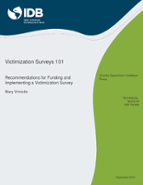Victimization Surveys 101: Recommendations for Funding and Implementing a Victimization Survey
Date
Sep 2015
While crime and violence are major global concerns, they are notoriously difficult to study, particularly in the developing world. Many crimes are never reported to police, and in many countries certain types of violence are not illegal, in which case there are typically no administrative records to collect. To better estimate this "dark figure" of unreported crime and violence, victimization surveys are a very useful tool. Although all surveys follow some core principles, surveys that measure rare events such as crime involve a host of considerations beyond those on topics most people have experienced or those measuring public sentiment. More effort and expense are therefore required to execute these surveys successfully. Setting reasonable goals, obtaining technical assistance from experts, and knowing how to select a survey firm will help ensure a quality survey is conducted. The author consulted several experts in victimization survey design to develop guidelines for anyone planning to fund or implement this endeavor. Key decisions that should be made at the outset are discussed, and characteristics of national surveys in five countries are compared. While national victimization surveys are typically only possible when financed by their governments, international organizations and NGOs may be able to finance surveys of urban areas when a national survey is not feasible. Detailed guidelines appear in the UN Manual on Victimization Surveys referenced at the end of this document with other key resources.




